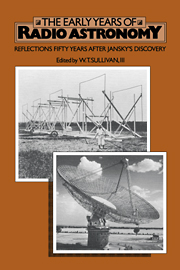Book contents
- Frontmatter
- Contents
- Preface
- THE EARLIEST YEARS
- AUSTRALIA
- The origins of radio astronomy in Australia
- The first decade of solar radio astronomy in Australia
- Early days in radio and radar astronomy in Australia
- Radio sources and the log N–log S controversy
- Early work on imaging theory in radio astronomy
- ENGLAND
- THE REST OF THE WORLD
- BROADER REFLECTIONS
- Biographical notes on contributors
- Name index
- Subject index
Radio sources and the log N–log S controversy
Published online by Cambridge University Press: 05 March 2010
- Frontmatter
- Contents
- Preface
- THE EARLIEST YEARS
- AUSTRALIA
- The origins of radio astronomy in Australia
- The first decade of solar radio astronomy in Australia
- Early days in radio and radar astronomy in Australia
- Radio sources and the log N–log S controversy
- Early work on imaging theory in radio astronomy
- ENGLAND
- THE REST OF THE WORLD
- BROADER REFLECTIONS
- Biographical notes on contributors
- Name index
- Subject index
Summary
The Sydney-Cambridge controversies of the 1950s concerning the nature of radio sources and their role in cosmology remain of interest because the roots of the controversies appear to lie in differing philosophies of scientific research as much as in observational discrepancies. They also clearly show the influence of instrumental limitations of the time on the beliefs of astronomers and thus contain a message for the new generation.
The controversies have been discussed at length by Edge & Mulkay (1976) but there remains a great deal which can be said. Edge & Mulkay aimed to give an objective account but did not have direct access to Australian material or contact with those of us involved in the controversies. Here I try to present my personal viewpoint of the time, as much, that is, as I am now able to reconstruct. My uncertain memory of some of these ancient events has been bolstered by access to the correspondence files of the Division of Radiophysics, with the kind permission of Dr. R.H. Frater, Chief of the Division.
EARLY YEARS
Nowadays it is difficult to appreciate the abysmal ignorance of the nature of radio sources prevalent around 1950. We were struggling with inadequate instruments to make physical sense of some completely new and unexpected phenomena. There were but two types of instrument, interferometers comprising pairs of low directivity antennas (or the equivalent single antenna on a cliff-top overlooking the sea) and single small-size antennas operating at low frequencies with poor resolution. Accordingly, the sky appeared to be populated by randomly distributed ‘point sources’, which produced interferometer patterns, and a broad band of rather featureless emission concentrated to the plane of the Milky Way.
- Type
- Chapter
- Information
- The Early Years of Radio AstronomyReflections Fifty Years after Jansky's Discovery, pp. 147 - 166Publisher: Cambridge University PressPrint publication year: 1984
- 13
- Cited by



